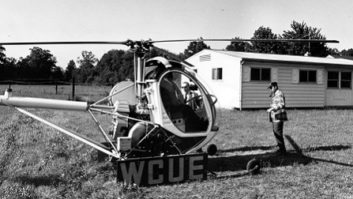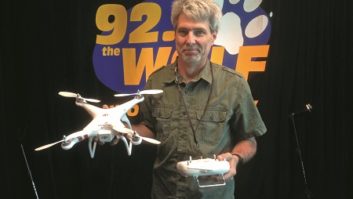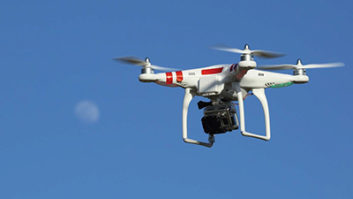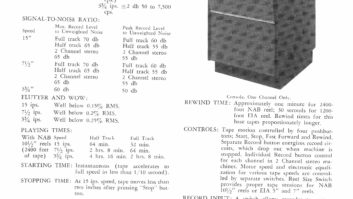(click thumbnail)Fig. 1: Brian Edwards holds cables that carry two tags each.
(click thumbnail)Fig. 2: Protect the cable ID label with clear heat shrink.
(click thumbnail)Fig. 3: Good planning on the part of his predecessors helps WTEM’s Merl Rinehart punch wires.Pulling cable? Make sure you place two labels on the cable runs, as shown by Brian Edwards, technical director for New World Radio in Fig. 1. If one label gets ripped off or damaged, identification is still easy.
When you’re ready to punch down the cables, protect the cable identification label with clear heat shrink, as shown in Fig. 2.
The same kind of cabling identifiers are used in the tower control cabinet for WTEM(AM), a 50-kW Clear Channel station in Washington, D.C. The site was constructed several years ago when Greater Media owned the station. Chief Engineer Merl Rinehart, shown in Fig. 3, has plenty of space to make punches, thanks to the well-planned wiring.
These are the kind of sites that make it a pleasure to go to work.



. . .
I guess it was first noticed during Desert Storm – periodic satellite outages that couldn’t be explained.
Jerry Weddle, resident satellite expert at Harris’ Broadcast Center, passed on a solution he provided for one of his customers.
The client’s engineer had spent a week trying to track down the interference. The client then paid frequency search firm Comsearch to identify the problem.
The interference shows up in analog as two streaks across the satellite video with a period of 10 seconds. It lasts for 20 minutes or so, then goes away for various lengths of time. Sometimes the interference shows up as a blast of oblong white sparkles.
Looking at the output of the Phase Locked Loop Low-Noise Blocks, a serious carrier is noted at 1900 MHz, with harmonics going right into 950-1450. It can only be seen with the analyzer in max hold. The carrier is 20 MHz wide.
Comsearch figured out that it was an AWACS plane. It’s putting out so much power that it is overloading the front end of the LNBs, especially the 25-degree models.
The problem has been experienced in most major markets and near many other satellite users who work near military air bases. But it can occur anywhere the planes fly.
Jerry’s cure for the problem is a Microwave Filter Co. 7892D filter. The filter provides excellent rejection and has the added benefit of removing radar altimeter interference.
Jerry says the filters sell for less than $500. Contact him at (800) 622-0022 for more information.
. . .
Commstruction engineer Ed Bukont just did a realign from GE-3 to GE-8, and was surprised at how close the carriers are at that end of the sky.
The coordinate program said the bird would be at 13.3 degrees. Ed found the carrier, all right, but not the one he wanted. He cranked up the dish to 15 degrees, and there was GE-8.
Thank goodness for the spectrum analyzer, as you won’t perform this kind of realign without one. The acquisition delay of the receiver prevents you from locating the bird using conventional methods.
Mike McCarthy, of McCarthy Radio Engineering adds that if you haven’t upgraded to a 3.8-meter dish, you may run into adjacent bird splatter because of the older dishes’ lack of selectivity.
. . .
Here’s a stumper: You have a perfectly working StarGuide receiver, with all the lights and asterisks in the right place – but there is no audio.
Neither card produces audio, but if the audio card is swapped to another receiver, it works fine. When a working card from a working receiver is installed, still no audio.
Think about it. We’ll offer some ideas below.
. . .
Oscar Medina is the director of engineering with KNSD(TV) in San Diego. He experienced an unusual problem with his TFT EAS 911.
Normally, when the RMT or “activation request” is received, the “message waiting” light will illuminate and begin blinking. When the operator presses the button, the light will extinguish and the manual forward light will illuminate and begin blinking.
Pressing the “manual forward” will initiate the sending of the header, tones, voice message and EOM.
In Oscar’s case, when a RMT or activation request was received, the “message waiting” light would illuminate, and begin blinking. Pressing the “message waiting” would cause the light to extinguish, but none of the other buttons would illuminate.
The EAS-911 would appear to be back in “standby” mode. If you pressed the “manual forward” button, the machine would forward the message in memory. The problem was for the staff; when the “manual forwarding” button would not light, there was confusion as to the next step to take.
The LED was fine, and the problem appeared to be logic-driven. Prior to sending the unit back to the factory, Oscar’s staff reset the unit by unplugging it, and also disconnecting the memory battery, by sliding a small piece of poster board between the battery and the upper terminal.
Doing this forced them to reprogram the unit, but the reset fixed the problem.
. . .
Now back to that pesky Starguide receiver.
Fee Lee, a former Westwood engineer who now is with Denny & Associates in Washington, suggests checking the 5-volt supply. The receiver may have lost some of its permissioning, and a low supply can cause this problem.
The supply must be set at least to 5 VDC, preferably 5.1. It’s a good idea to check the Molex plugs on the power supply cable for corrosion and tightness.
Submissions for this column are encouraged and qualify for SBE recertification credit. Fax your submission to (703) 323-8044, or send e-mail to [email protected]











